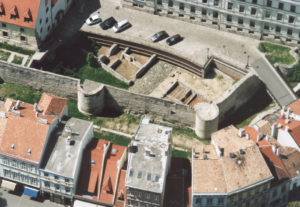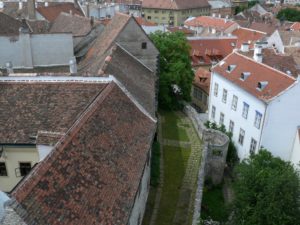Sopron

Sopron (Ödenburg) is located in western Hungary, it was called Scarbantia in the Roman Empire age. It was a strategic castle and city right before Vienna – one more obstacle for the attacking Ottoman enemy. The inner city was surrounded by a 2-3-meter-wide stone wall in the Roman age, it was the basis for the medieval fortification. In the 9th–10th centuries, Hungarians strengthened the old Roman city walls and built a wooden wall on the great stones. Location: https://tinyurl.com/d3wkhstb

When the Magyar tribes arrived in the 9th century, Sopron was uninhabited and in ruins. The Hungarian Osl Clan settled in the area, they were the descendants of Chief Sur. King Saint István was the one who had the first wooden palisade built on the Roman walls in 1031 when he was marking the border of the kingdom. This fort was first mentioned in September 1096 when King Kálmán received the French Crusaders who were escorted to “ad castellum Cyporen”. Later, the town was given a Hungarian name after a castellan called Suprun in 1135. In 1153, it was mentioned as an important town.

The first king who gave privileges to Sopron was King Béla IV and King István V. Later, these rights were confirmed by the succeeding kings. There was a German castellan of Sopron, one called Páter (first mentioned in 1265) who ceded the castle to the Bohemian King Otakar II in 1273, during the Bohemian wars of King István and King László.
Even though the Czech monarch took the children of Sopron’s nobility with him as hostages, the city opened its gates when the armies of King László/Ladislaus IV of Hungary arrived in 1277. The king (who reigned between 1262 and 1290) rewarded Sopron by elevating it to the rank of a free royal town in the same year. Thus, Sopron gained equal rights and privileges with Székesfehérvár, the capital of the kingdom. Castelan Páter was tried for treason and he was beheaded in 1278.

King László was the one who began the castle’s construction in earnest but the 8-10 meters high inner wall was finished only between 1297-1340. By 1344, the moat surrounding the walls was also completed. Then, the Roman wall of the inner city was fortified with small towers protruding in front of the walls. There was a rampart on the top of the wall, with loopholes that stood 2.5 meters from each other.

After the death of King Habsburg Albert, perhaps the only good Habsburg king of Hungary who was beloved, Sopron was pledged to Emperor Frederick III in 1441 for 8,000 gold ducats by King Albert’s widow, Queen Elisabeth. It was only King Matthew who could get it back when he agreed with Frederick in 1464 to buy back these territories along with the Holy Crown of the Hungarians for 80,000 gold ducats. That was a staggering sum, Frederick doubted it would be ever paid but it was.
The so-called First Gate was mentioned in 1465. It stood at the northern part of the castle, protected by a tower gate and a double drawbridge. The Back Gate was on the other side of the city and it was built in 1394. The city used to be a rapidly growing trading and market center next to the Austrian border. For a short time, King Matthias pledged Sopron to Weisspriach Zsigmond in 1471, in exchange for 10.4000 gold Forints.

After the Battle of Mohács, the burghers banished the Jews from the city in 1526. Later in 1543, the Council of the Town banned the “foreigner Hungarians” from buying a house in the city. The Ottoman Turks ravaged the city in 1529 but could not occupy it. Many Hungarians fled from the Turk-occupied areas to Sopron, and the city’s importance was growing. Sopron became a kind of center in Royal Hungary. Several Diets were held here in 1553, 1622, 1625, 1635, and 1681.
While the Ottomans occupied most of central Europe, the region north of Lake Balaton remained in the Kingdom of Hungary (1538–1867) (captaincy between Balaton and Drava). Sopron was always taken care of and was well supplied by the Habsburgs because it was close to their capital and was defending Vienna.

The Hungarian language was banned from the city’s administration in 1594. The army of Prince Bocskai István of Transylvania, led by Hagymássy Kristóf, was trying to take Sopron castle in 1605 but their siege was unsuccessful. (Please, note that I use the Eastern name order for Hungarians where family names come first.)

However, after Prince Bocskai’s troops pillaged the city, the inhabitants erected more bastions. The 8-meter-high round bastion was assumedly built around 1614, its wall was 3.5-meter-wide. When the troops of Prince Bethlen Gábor of Transylvania arrived there in 1619, Sopron, similar to many Hungarian towns, opened its gates. Shortly after this, a truce was made and Sopron returned to the Habsburg king who wore the crown of the Hungarian Kingdom.

You can read more about the 1,000-mile-long Hungarian Borderland here:
https://www.hungarianottomanwars.com/essays/the-borderland/
Sopron’s population in 1633 was 4,070 people. It was also a coronation town: Ferdinand II’s second wife, Queen Eleonora was crowned here in 1622. The Diet of Sopron elected Ferdinand II’s son, Duke Ferdinand to be King of Hungary in November 1625, he was accordingly crowned there in December.

Due to the religious persecutions, many Evangelic Austrians moved to Sopron in the first decade of the 17th century. The most famous of them was the aristocrat Eggenberg family but renowned intellectuals and craftsmen, merchants had come from all over Austria. For example, Andreas Rauch, the famous organ artist, arrived there from Vienna in 1628, and Johann Sartory, a chemist, in 1629.
A famous Society of Noble Scientists was established in the city by Kristóf Lackner, a City Judge, in 1604. It was similar to a guild of intellectuals; its members were Gábor Lampert, a pastor from Balf, Münderer Gottfried, pastor of Borbolya in 1623, or Jeremias Scholtz, a physician in 1625. Despite the sophisticated atmosphere, there was a nasty witch case going on in 1630.

Half of the people died in 1655 in the plague and in 1676, Sopron was destroyed by a fire. The modern-day city was born in the next few decades when Baroque buildings were built to replace the destroyed medieval ones. The army of Prince Thököly Imre of North Hungary and Transylvania occupied Sopron in 1683 but soon, they were driven out by the Austrian army led by General Starhemberg.
The city didn’t support the Revolution of Prince Rákóczi Ferenc and resisted successfully for three weeks against his troops in 1705. However, later it was taken by the army of General Bottyán. When the War of Independence of Rákóczi ended in 1711, the military role of Sopron ceased to exist anymore. They began to pull down the walls and the bastions but some sections and a round bastion can be seen in our days.

Sopron has been called Civitas Fidelissima (“The Most Loyal/Faithful Town”) because its inhabitants were granted the right to vote on this issue. Finally, they decided to stay within the boundaries of Hungary after 1921.

Dear Readers, I can only make this content available through small donations or by selling my books or T-shirts:
Please, feel free to support me with a coffee here:
You can check out my books on Amazon or Draft2Digital, they are available in hardcover, paperback, or ebook:
https://www.amazon.com/dp/198020490X or at https://books2read.com/b/boYd81

My work can also be followed and supported on Patreon: Become a Patron!http://Become a Patron!

[wpedon id=”9140″]

https://hungarianottomanwars.myspreadshop.com/all




















